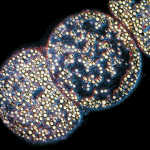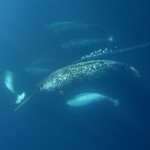 The Gulf of Mexico oil spill continues to worsen. Choppy seas and unfavorable winds have hindered cleanup efforts, and fishing has been suspended from Lousiana to Florida. While all the news coverage mentions that this is an environmental catastrophe, few articles have gone into details on exactly what that means. Here’s a brief summary of exactly how this oil spill may affect the Gulf wildlife, recreation, and fishing industries:
The Gulf of Mexico oil spill continues to worsen. Choppy seas and unfavorable winds have hindered cleanup efforts, and fishing has been suspended from Lousiana to Florida. While all the news coverage mentions that this is an environmental catastrophe, few articles have gone into details on exactly what that means. Here’s a brief summary of exactly how this oil spill may affect the Gulf wildlife, recreation, and fishing industries:
Direct oiling. Obviously, spilling a whole bunch of oil means that shorelines and animals get covered in oil. This is most obvious – and poignant – in large animals that use the shoreline, such as seabirds, otters, and seals. (Tiny 8-year-old Miriam cried her eyes out at images of oil covered birds trying to clean themselves during the Exxon Valdez spill). Direct oiling can also smother bottom-dwelling invertebrates such as oysters and mussels, and cause mass dieoffs of habitat-creating plants such as marsh grasses and seaweeds (see Habitat destruction section below).

Indirect effects of oiling. This is pretty much the worst possible time of year for a giant oil spill, since so many animals are on the move during spring migration, and will therefore come into contact with the oil. For example, the endangered Kemp’s Ridley sea turtle is in the midst of migrating across the Gulf, songbirds are flying back to North America from the tropics, and the poor beleaguered bluefin tuna is coming into the Gulf to spawn. While these animals may not immediately die from being coated in oil, ingesting or inhaling smaller amounts can cause also cause severe illness and death. Birds and marine mammals who ingest or inhale oil while cleaning themselves or breathing at the surface of the water experience lung, liver, and kidney damage. Similarly, fish can inhale oil while breathing though their gills, which causes organ and tissue damage.
Reproductive failure. Oil is extremely toxic to fish and invertebrate eggs & larvae. In laboratory experiments, fish embryos died when exposed to just 1 ppb of partially weathered crude oil. The good news is that complete reproductive failure is not unknown in the ocean – entire generations of birds and seals have died as a result of El Nino – and that as long as the adults survive to reproduce another year, it’s possible for the populations to recover. Unfortunately, they need a place to reproduce. Which brings us to the scariest ecological impact of an oil spill:
Habitat destruction. Many key coastal habitats are formed by plants, such as sea grasses, mangroves, and marsh grasses. These are critical for thousands of species, particularly commercial and recreational fisheries, because they provide three-dimensional structure for juvenile animals to hide from predators. Severely damaging or destroying these habitats can have effects for many years, since future generations of fish, crab, and shrimp will have no place to grow up.

Long-term chronic effects. While acute exposure to oil is dramatic, the long term chronic effects can be worse. A 2003 report on the Exxon Valdez recovery found that the area actually showed long-term ecological instability. In the tidepools, the mass die-off of seaweed had left habitat open to barnacle colonization, which inhibited the recovery of seaweed, which led to another mass die-off when the seaweed that did manage to move in all died of old age at the same time. More than 10 years after the spill, black oystercatchers that foraged on oiled shores had reduced breeding and smaller eggs than animals that foraged elsewhere. The local orca pod has not recovered, which the report’s authors attribute to social instability stemming from the oil-related deaths of the pod matriarchs. For reasons that are unclear region’s herring fishery has also failed to recover. The authors note:
Oil effects also are substantial (independent of means of insulation) over the long term through interactions between natural environmental stressors and compromised health of exposed animals, through chronic toxic exposure from ingesting contaminated prey or during foraging around persistent sedimentary pools of oil, and through disruption of vital social functions (care giving or reproduction) in socially organized species.
Additional resources
- Official Gulf oil spill page from the NOAA Office of Response and Restoration
- The US Fish & Wildlife Service has a short, readable fact sheet on impacts of oil spills on wildlife (PDF).
- A vast trove of Exxon Valdez-related links from NOAA
- The Australian Maritime Safety Authority has a comprehensive oil spill website, with sections for kids and teachers.






DRILL, BABY….never mind.
In just days this has gone from disaster to catastrophe. Again, videotapes of their stupid chant at the GOP convention two years ago only makes them look idiotic in hindsight. They ALWAYS look idiotic in hindsight. Did you ever notice that?
We have a choice to make: The environmental security of our planet or the private profit of a very few. This really is a no-brainer when you come to think about it.
http://www.tomdegan.blogspot.com
Tom Degan